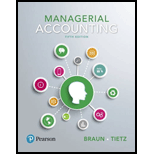
Managerial Accounting (5th Edition)
5th Edition
ISBN: 9780134128528
Author: Karen W. Braun, Wendy M. Tietz
Publisher: PEARSON
expand_more
expand_more
format_list_bulleted
Question
Chapter 5, Problem 5.58BP
1.
To determine
Time line for the Mixing Department.
2.
To determine
Summarized physical flow of units.
To compute: Total equivalent units.
3.
To determine
To compute: Equivalent cost per unit for direct material costs, materials introduced at end, and conversion costs.
4.
To determine
Total cost assigned to:
(a) Units completed and transferred out to Retort Department.
(b) Units in ending work in process inventory – Mixing Department.
Expert Solution & Answer
Want to see the full answer?
Check out a sample textbook solution
Students have asked these similar questions
What is the total cash payment Hudson will make on April 1, 2021?
General accounting
What is the common size percentage for the net fixed assets?
Chapter 5 Solutions
Managerial Accounting (5th Edition)
Ch. 5 - (Learning Objective 1) Which of the following is...Ch. 5 - (Learning Objective 2) Conversion costs consist of...Ch. 5 - (Learning Objective 2) Which of the following is...Ch. 5 - (Learning Objective 3) Which of the following is...Ch. 5 - Prob. 5QCCh. 5 - (Learning Objective 4) The journal entry needed to...Ch. 5 - (Learning Objective 4) A company has two...Ch. 5 - Prob. 8QCCh. 5 - Prob. 9QCCh. 5 - Prob. 10QC
Ch. 5 - Compare job costing and process costing (Learning...Ch. 5 - Prob. 5.2SECh. 5 - Prob. 5.3SECh. 5 - Determine the physical flow of units (process...Ch. 5 - Compute equivalent units (process costing Step 2)...Ch. 5 - Compute equivalent units (process costing Step 2)...Ch. 5 - Summarize total costs to account for (process...Ch. 5 - Prob. 5.8SECh. 5 - Prob. 5.9SECh. 5 - Prob. 5.10SECh. 5 - Prob. 5.11SECh. 5 - Prob. 5.12SECh. 5 - Prob. 5.13SECh. 5 - Prob. 5.14SECh. 5 - Prob. 5.15SECh. 5 - Prob. 5.16SECh. 5 - Continuation of S5-16: Record journal entry and...Ch. 5 - Compute equivalent units in second department...Ch. 5 - Prob. 5.19SECh. 5 - Prob. 5.20SECh. 5 - Prob. 5.21SECh. 5 - Prob. 5.22SECh. 5 - Analyze flow of costs through inventory T-accounts...Ch. 5 - Summarize physical units and compute equivalent...Ch. 5 - Prob. 5.25AECh. 5 - Prob. 5.26AECh. 5 - Continuation of E5-26A: Journal entries (Learning...Ch. 5 - Complete the production cost report in first...Ch. 5 - Prob. 5.29AECh. 5 - Analyze costs and gross profit in a process...Ch. 5 - Prob. 5.31AECh. 5 - Compute equivalent units and assign costs...Ch. 5 - Complete five-step procedure in first department...Ch. 5 - Sustainability and process costing (Learning...Ch. 5 - Complete five-step procedure and journalize result...Ch. 5 - Complete five-step procedure in second department...Ch. 5 - Exercises Group B E5-37B Analyze flow of costs...Ch. 5 - Summarize physical units and compute equivalent...Ch. 5 - Prob. 5.39BECh. 5 - Complete five-step procedure in first department...Ch. 5 - Prob. 5.41BECh. 5 - Prob. 5.42BECh. 5 - Prob. 5.43BECh. 5 - Prob. 5.44BECh. 5 - Record journal entries (Learning Objective 4)...Ch. 5 - Compute equivalent units and assign costs...Ch. 5 - Prob. 5.47BECh. 5 - Sustainability and process costing (Learning...Ch. 5 - Complete five-step procedure and journalize result...Ch. 5 - Complete five-step procedure in second department...Ch. 5 - Process costing in a single processing department...Ch. 5 - Process costing in a first department (Learning...Ch. 5 - Prob. 5.53APCh. 5 - Prepare a production cost report and journal...Ch. 5 - Prob. 5.55APCh. 5 - Process costing in a single processing department...Ch. 5 - Process costing in a first department (Learning...Ch. 5 - Prob. 5.58BPCh. 5 - Prepare a production cost report and journal...Ch. 5 - Prob. 5.60BPCh. 5 - Prob. 5.61SCCh. 5 - Discussion Questions 1. What characteristics of...Ch. 5 - Prob. 5.63ACTCh. 5 - Prob. 5.64ACTCh. 5 - Process costing and hybrid costing issues...
Knowledge Booster
Learn more about
Need a deep-dive on the concept behind this application? Look no further. Learn more about this topic, accounting and related others by exploring similar questions and additional content below.Similar questions
- I need help with this general accounting question using standard accounting techniques.arrow_forwardI am searching for the correct answer to this general accounting problem with proper accounting rules.arrow_forwardThe following direct labor information applies to Summit Tech Co. for the month of April: • Actual labor rate = $12.50 per hour • Actual hours worked = 12,000 hours • • Standard labor rate = $12.00 per hour Standard hours allowed = 11,200 hours Calculate the following: 1. Labor rate variance 2. Labor efficiency variance 3. Total labor variancearrow_forward
- I am searching for the correct answer to this general accounting problem with proper accounting rules.arrow_forwardI am looking for the correct answer to this financial accounting problem using valid accounting standardsarrow_forwardCan you help me find the accurate solution to this financial accounting problem using valid principles?arrow_forward
arrow_back_ios
SEE MORE QUESTIONS
arrow_forward_ios
Recommended textbooks for you
 Cornerstones of Cost Management (Cornerstones Ser...AccountingISBN:9781305970663Author:Don R. Hansen, Maryanne M. MowenPublisher:Cengage Learning
Cornerstones of Cost Management (Cornerstones Ser...AccountingISBN:9781305970663Author:Don R. Hansen, Maryanne M. MowenPublisher:Cengage Learning Managerial AccountingAccountingISBN:9781337912020Author:Carl Warren, Ph.d. Cma William B. TaylerPublisher:South-Western College Pub
Managerial AccountingAccountingISBN:9781337912020Author:Carl Warren, Ph.d. Cma William B. TaylerPublisher:South-Western College Pub Financial And Managerial AccountingAccountingISBN:9781337902663Author:WARREN, Carl S.Publisher:Cengage Learning,
Financial And Managerial AccountingAccountingISBN:9781337902663Author:WARREN, Carl S.Publisher:Cengage Learning,

Cornerstones of Cost Management (Cornerstones Ser...
Accounting
ISBN:9781305970663
Author:Don R. Hansen, Maryanne M. Mowen
Publisher:Cengage Learning

Managerial Accounting
Accounting
ISBN:9781337912020
Author:Carl Warren, Ph.d. Cma William B. Tayler
Publisher:South-Western College Pub

Financial And Managerial Accounting
Accounting
ISBN:9781337902663
Author:WARREN, Carl S.
Publisher:Cengage Learning,
Inspection and Quality control in Manufacturing. What is quality inspection?; Author: Educationleaves;https://www.youtube.com/watch?v=Ey4MqC7Kp7g;License: Standard youtube license